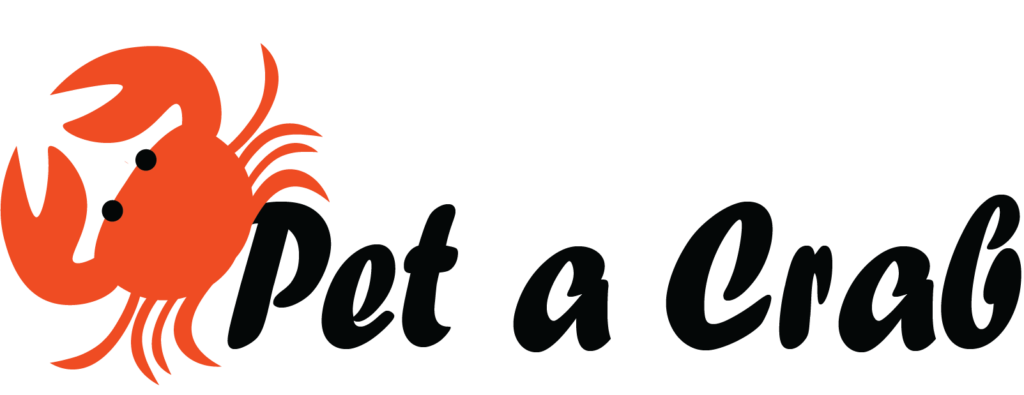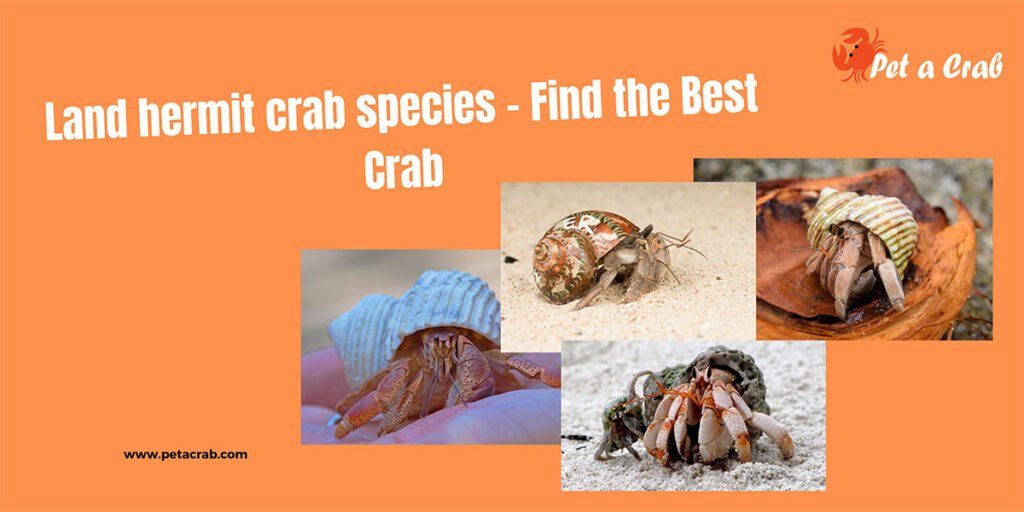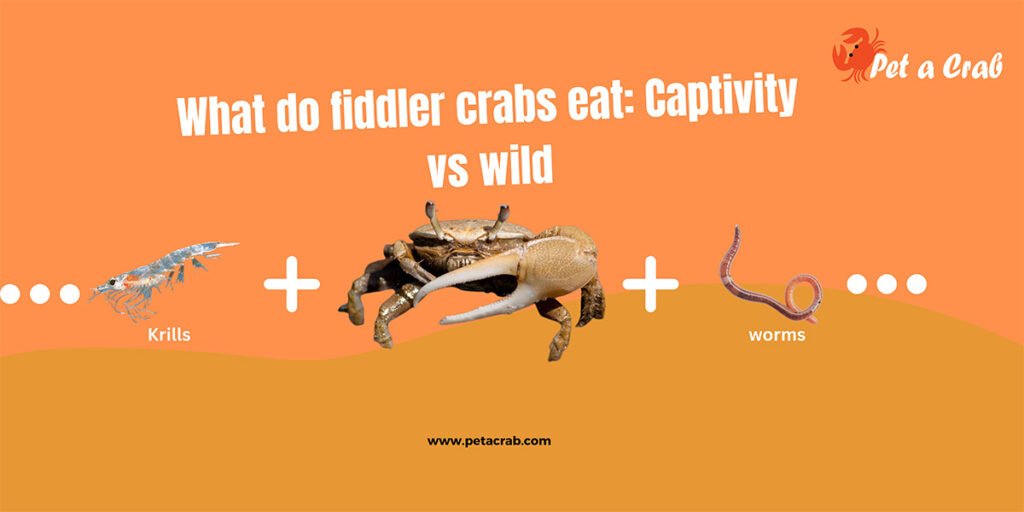Interesting facts about crabs show an exciting view of the realm of crustaceans. While there are more than 6,800 species of decapods in the world, they seem to be a staple in marine ecosystems. Crabs, with their exoskeleton and ability to move sideways, display exceptional adaptations that are unrelated to their unique reproductive techniques or limb regeneration abilities.
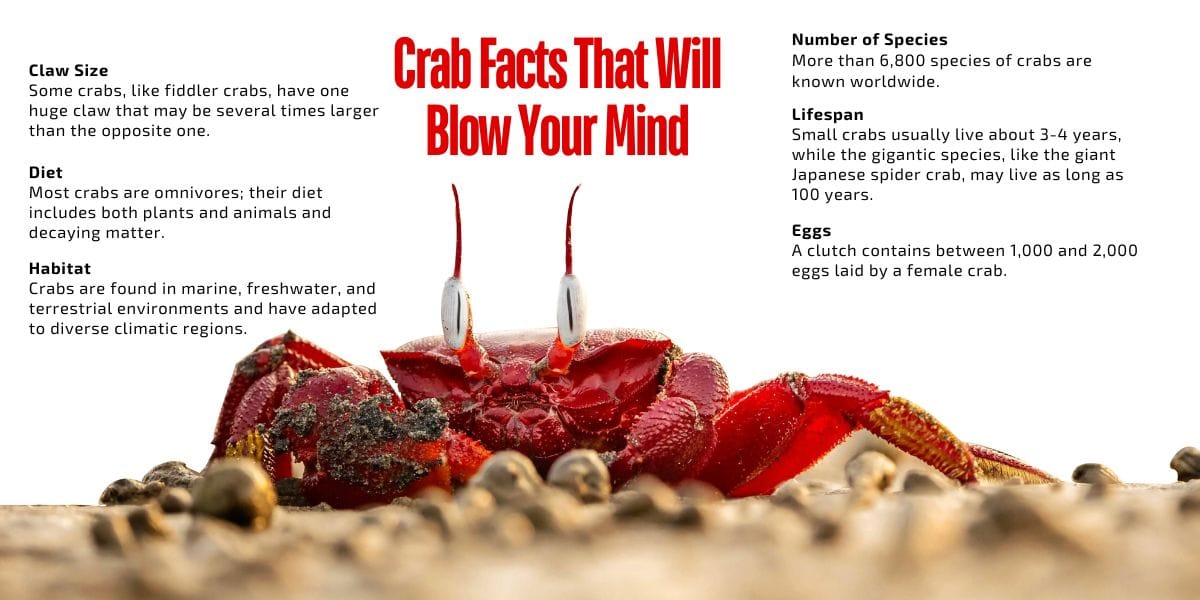
In this article, we will be discussing information like anatomy, habitats, diets, and ecological functions—all about crabs in great detail with regard to these resilient and varied creatures. If you are excited to learn just why crabs are crucial to our ecosystem, read on, brought to you by Petacrab.
Note: we’ll be talking 50-100 facts about crabs
10 Facts About Crabs
Species Number Info: More than 6,800 species of crabs are known worldwide.
Lifespan: Small crabs usually live about 3-4 years, while the gigantic species, like the giant Japanese spider crab, may live as long as 100 years.
Eggs: A clutch contains between 1,000 and 2,000 eggs laid by a female crab.
Habitat: Crabs are found in marine, freshwater, and terrestrial environments and have adapted to diverse climatic regions.
Diet: Most crabs are omnivores; their diet includes both plants and animals and decaying matter.
Claw Size: Some crabs, like fiddler crabs, have one huge claw that may be several times larger than the opposite one.
Temperature Regulation: Crabs are ectothermic; they take the temperature of their surroundings to regulate their body’s heat.
Breathing: Crabs possess gills, which enable them to respire underwater; however, some crabs have undergone metamorphosis to breathe air on land.
Colour Changes: Some species of crabs, like the blue crab, change colour based on changes in the environment.
Molting: Crabs change out their exoskeletons, a process called molting, several times during their life cycle as they get larger.
Fun Facts About Crabs – Fun Crab Facts
- Crabs are decapods, meaning they have ten legs—eight walking legs and two claws.
- While crabs can walk in any direction, they prefer to move sideways for speed and agility.
- The fiddler crab has one claw significantly larger than the other, which it uses to attract mates and ward off predators.
- Some crabs can regenerate lost limbs during their molt cycle, making them highly adaptable.
- Crabs can live both in water and on land, with certain species like the coconut crab living exclusively on land.
- A fun fact about crabs is that they can communicate by waving their claws or using vibrations to signal others.
- Ghost crabs are known for their incredible speed, running up to 10 miles per hour.
- One interesting fun fact about crabs is that they have a hard exoskeleton, called a carapace, which helps protect them from predators.
- The peacock crab can produce a high-pitched sound when it feels threatened, using its claws.
Interesting Crab Facts
Here are 10 interesting facts about crabs; the top 3 are the most interesting.
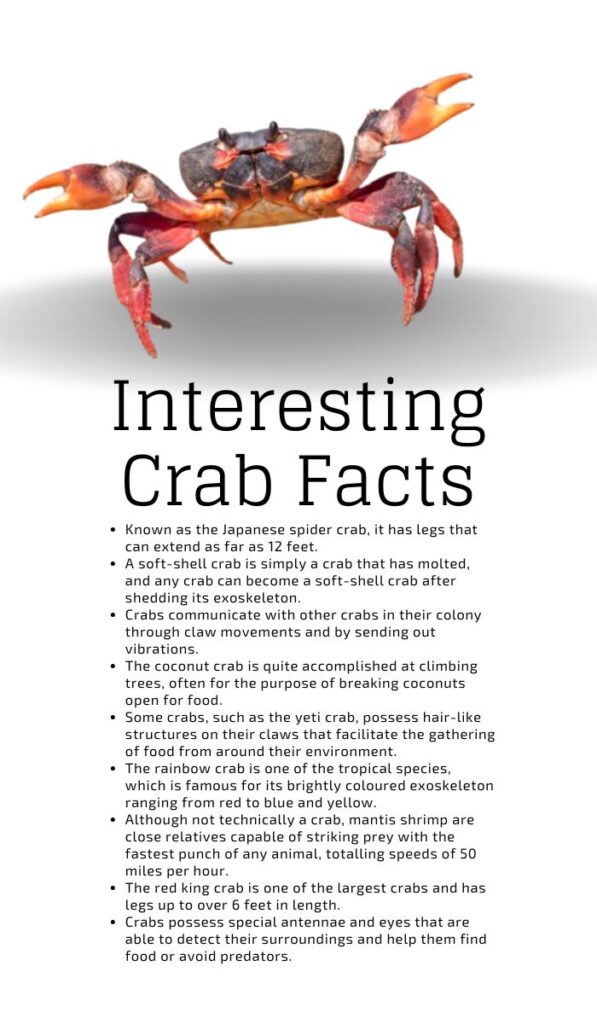
- Known as the Japanese spider crab, it has legs that can extend as far as 12 feet.
- Crab exoskeleton facts: A soft-shell crab is simply a crab that has molted, and any crab can become a soft-shell crab after shedding its exoskeleton.
- Crabs communicate with other crabs in their colony through claw movements and by sending out vibrations.
- The coconut crab is quite accomplished at climbing trees, often for the purpose of breaking coconuts open for food.
- Yeti crab facts: Some crabs, such as the yeti crab (lifespan: 10 to 20 years), possess hair-like structures on their claws that facilitate the gathering of food from around their environment.
- The rainbow crab is one of the tropical species, which is famous for its brightly coloured exoskeleton ranging from red to blue and yellow.
- Although not technically a crab, mantis shrimp are close relatives capable of striking prey with the fastest punch of any animal, totalling speeds of 50 miles per hour.
- The red king crab is one of the largest crabs and has legs up to over 6 feet in length.
- Crabs possess special antennae and eyes that are able to detect their surroundings and help them find food or avoid predators.
- The Tasmanian giant crab is one of the heaviest crabs, reaching a weight of up to 26 pounds and their claw strength is capable of exerting up to 810 pounds of force with just one pinch.
Fascinating Facts on Crabs
- Crabs are the oldest living creatures on Earth, dating back over 200 million years.
- In nature, rainbow crabs have vivid, multicoloured exoskeletons, making them a stunning sight.
- As long as they keep their gills moist, crabs can breathe underwater and on land.
- A box crab can completely retract into its hard shell, making it virtually invisible to predators.
- Every year, millions of red crabs migrate to the sea to breed on Christmas Island.
- Some crab species are known for their strength, lifting objects many times their own weight.
- Known only since 2005, the yeti crab harvests bacteria with its furry pincers, which help it survive deep in the sea.
- Crabs can grow up to 9 pounds in weight, making them the largest arthropod on land.
- Some species of crabs use their claws to decorate their shells with algae, shells, or seaweed to camouflage themselves from predators.
Crab Facts for Kids/kindergarten/preschoolers
Here are some cool facts about crabs for Kids/kindergarteners/preschoolers
- Crabs have ten legs and two claws, and they walk sideways because it’s faster for them!
- When crab larvae grow, they shed their exoskeleton.
- Some crabs, such as the hermit crab, will find themselves an empty shell on the beach for protection.
- Wave and communicate with other crabs using the big claws of fiddler crabs.
- Did you know crabs can regrow their claws if they lose them? That’s pretty cool, I must say!
- With its claws, the coconut crab can crack open coconuts.
- Whether living in the deep ocean, beaches, or tropical islands, crabs have a wide range of habitats.
- When crabs feel threatened, they can rub their claws together and make a noise.
- Some crabs have colourful claws, which are used for showing off to other crabs; such as the peacock crab.
- Crabs, like ghost crabs, are capable of running fast and usually are difficult to catch.
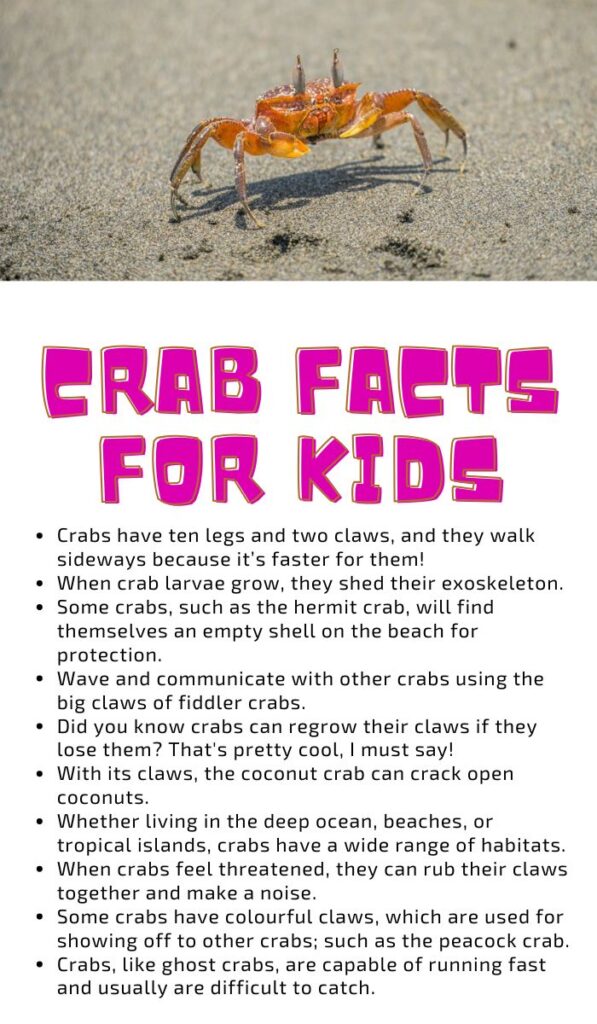
Crab Facts for All Ages
- Crabs are very hardy and can survive under most conditions on land or at sea.
- Crabs eat with their pincers, fight with them, and even attract mates with them!
- Some crabs, including the blue crab, possess blue-coloured blood because oxygen is transported by copper, not iron.
- Crabs can lift up to 28 pounds using their claws, which makes the coconut crabs the largest terrestrial arthropods.
- From icy Arctic waters to tropical beaches in the Pacific, crabs can thrive anywhere.
- Every year, more than 120 million crabs migrate from Christmas Island to the mainland.
- Crabs can survive high-pressure conditions, especially in deep-sea environments, because their bodies have adapted to extreme temperatures and depth levels.
- Some, like the fiddler crab, can even display dominance with the wave of a larger claw.
- The Tasmanian giant crab is the largest of the species and can grow to a leg span of 13 feet across.
Where Do Crabs Live? Info About Crabs
The adaptability of crabs allows them to thrive in a variety of environments. From shallow shores to deep underwater, most of them live in the ocean. Some crabs live in salt water as well as fresh water. Coconut crabs and hermit crabs live on land. In addition to burrows in sand or mud, some crab species use empty shells as shelters to conceal themselves.
How Many Types of Crabs Are There?
They are widespread, with each crab species having different types of characteristics, features and adaptations. Among the most notable types are:
A very popular species of crab that is known to have sweet and tender meat, native to the Atlantic and Gulf coasts. In seafood cuisine, these crabs are highly sought after.
This crab has large claws, making it suitable for colder waters, like Alaskan waters. It is known for the richness and flavour of its meat.
There is no hard shell on hermit crabs, unlike other crabs. They use empty snail shells to protect themselves from predators. Most of them live along the coast.
The claws of these small crabs are asymmetrical, with one claw much larger than the other. It is the males’ large claws that attract females.
A crab like this lives in the Indian and Pacific oceans, where it is the largest terrestrial arthropod. In addition to climbing trees, it can crack open coconuts.

What Do Crabs Eat?
As omnivorous scavengers, crabs consume both plants and animals. Depending on their environment and what food sources are available, their diet is varied and adaptable. Common crab foods include:
Algae
Crabs graze on algae found on rocks, seaweed, and other submerged surfaces.
Plankton
Microplankton, which is a small, drifting organism in the water, is also a food source for them.
Small Invertebrates
A crab will eat worms, molluscs, and snails.
Fish
Crabs will eat the smaller fish, like minnows, or other fish that have died as scavengers.
Carrion
Being opportunistic feeders, crabs consume the decaying bodies of dead animals, including dead crustaceans.
Decaying Matter
Crabs are also useful in cleaning their surroundings as they feed on detritus, a decaying material from plants and animals.
Fungi
Those crabs that live in damp environments consume fungi, such as mushrooms and mold. Some crab species eat specialized diets. As an example:

- The diet of fiddler crabs includes algae and small worms/invertebrates from within their burrows.
- Land crabs, such as coconut crabs, are more likely to consume fruits, seeds, and leaves.
- Among the foods eaten by Dungeness crabs are small fish, snails, and other crustaceans.
How can I Make the Perfect Crab Habitat?
Creating the perfect habitat would be essential, as it would ensure your crab leads a healthy life. In setting up your crab habitat, there are several important factors to focus on space, humidity, temperature, and diet specifications, which might all vary according to species.
Tank Setup
First of all, a proper selection of a tank is required to be able to accommodate the crab to move freely inside and thus provide the space needed for cover and climbing and burrowing areas. In particular, hermit crabs burrow and dig in soft substrates, such as play sand. Protect the tank with a lid as well.
Temperature and Humidity
Crabs are sensitive to temperature and humidity, so these are maintained accordingly. Land crabs, like hermit crabs, prefer to maintain a temperature between 22°C to 27°C. If your area is too cool, heat can be provided with under-tank heaters. Second, crabs need high humidity, from 70-80%. You could raise the humidity by spraying the cage regularly or using a humidifier.
Shelter and Substrate
Some facts are that crabs are animals that like to hide, climb, and burrow; therefore, the amount of shelter within the habitat should be plentiful. The animals may rest or hide in natural objects such as shells, rocks, or driftwood. The hermit crab provides a variety of shell sizes for growing. In addition to plants and moss, you could use bark, since it has texture and hiding places.
Diet
Being opportunistic omnivores, crabs require a rounded diet to stay healthy. You will be able to give them fruits and vegetables, proteins such as small pieces of fish or chicken, and even seaweed. Provide fresh water and a saltwater dish each day, changing both often to keep them clean. Furthermore, calcium is added to their diet through foods like crushed eggshells to help maintain a healthy exoskeleton.
Cleaning and Maintenance
Clean regularly to avoid the accumulation of filth and bacteria. Remove uneaten food; clean the walls if there is a need, and change the substrate when necessary. This will help keep your crab healthy and fit.
Why Are Crabs Important to the Ecosystem?
Crabs perform a vital function in keeping ecosystems either on land or in the sea healthy and in a balanced state. Here are a few of their many contributions:
Nutrient Recycling
A crab is a scavenger that helps decompose organic matter. They can recycle the nutrients into the environment, as they consume dead plants and animals, enriching the soil or seabed.
Habitat Maintenance
Species such as the mangrove crab are crucial to the health of a mangrove forest, serving to aerate the soil and keep plant growth, such as algae, in check that might otherwise assume dominance over the ecosystem.

Food Source
Crabs are a source of food for many predators ranging from fish, birds, and even large marine mammals. Their presence supports a proper food web.
Population Control
By feeding on small creatures like mussels or plankton, crabs prevent an ecosystem’s population from overgrowing.
Shoreline Protection
Some species, like the coconut crab, help maintain the stability of sandy beaches and coastal environments, preventing erosion through their burrowing activities.
Research and Evidence on “Crab Animal Facts”
Like many marine animals, crabs have long been exposed to cruel conditions, including being boiled alive, many times with the least concern for their welfare. However, recent scientific research has questioned this belief that crabs are not sentient. In 2021, a study from the London School of Economics looked into more than 300 studies concerning decapods, like crabs and lobsters, to appraise their cognitive and sensory abilities.
Evidence suggests crabs act as sentient beings when they learn and respond to threats. They claim that crabs, including decapods, are sentient mammals, and that they can feel pain and distress as a result.
As the lead author of the report, Jonathan Birch said, “It has been shown that crabs have a complex nervous system that allows them to feel pain. Therefore it is worth challenging the scientific and culinary treatment of these remarkable animals.”.
Crab Nutrition Facts – Bonus Section
When it comes to seafood, crab’s one of those fancy yet feel-good choices that seems indulgent but is surprisingly wholesome. Whether you’re cracking open snow crab legs, digging into a crab cake, or spreading cream cheese-filled crab rangoon onto a plate, it’s good to know what you’re actually fuelling your body with.
Let’s simplify it all—quality over confusion.
Crab Meat Nutrition Facts – Straight from Sea to Plate
Crab meat, especially from blue crab and king crab, packs lean protein, omega-3s, and vitamins like B12 and selenium. A 3-ounce serving offers around 97 calories, 20 grams of protein, and barely any fat source. Rich, satisfying, and light? Yes, please.
Blue Crab Nutrition Facts – Light, Flaky and Worth It
Blue crab is high in zinc and low in saturated fat, with roughly 85 calories and 17 grams of protein per 3 oz. It’s ideal for heart-conscious eaters without skipping taste.
King Crab Nutrition Facts – A Hearty Treat Without Guilt
King crab legs are large, sweet, and surprisingly clean. That same 3 oz gives around 82 calories, nearly 16 grams of protein, and less than 1 gram of fat. It’s like eating luxury that loves your body back.
Snow Crab Legs Nutrition Facts – Light Legs, Big Benefits
Nutrition Facts of Snow Crab Legs
For every 1 lb of snow crab legs, you’re looking at about 370 calories, 70 grams of protein, and just 2 grams of fat. It’s high in magnesium and phosphorus, making it great for bones and recovery.
Snow Crab Legs Nutritional Facts vs. Crab Meat
Both options are solid, but snow crab legs tend to be lower in calories and fat while still packing protein and flavor.
Crab Legs Nutrition Facts – Don’t Let That Butter Fool You
Crab legs on their own are lean, but watch the dips. Without butter, they’re an ace choice—protein-rich and low-carb. A serving of crab legs gives roughly 100 calories and 20 grams of protein.
Imitation Crab Nutrition Facts – Real or Not, Let’s Break It Down
Also known as surimi, imitation crab meat is a mix of white fish, starch, and flavoring. A 3 oz portion gives 81 calories, 6 grams of protein, and 13 grams of carbs source. It’s affordable, convenient, but lower in nutrients than real crab.
Artificial Crab Meat Nutrition Facts vs. Real Crab
It has more sodium and fewer nutrients. But for those watching budgets or eating sushi on the go, it’s still useful.
Crab Rangoon Nutrition Facts – Tasty but Handle with Care
Crab rangoon might taste like heaven, but it’s more of an indulgence. One piece has about 70-100 calories, depending on how it’s made. Most of that comes from cream cheese and deep frying, so moderation is key.
Crab Cake Nutrition Facts – Light or Loaded? Depends on the Recipe
Homemade crab cakes using little filler can offer around 150–200 calories per patty, loaded with crab’s goodness. Restaurant versions? Often 300+ calories with more fat and breadcrumbs.
Boiling Crab Nutrition Facts & Kickin Crab Nutrition Facts
These restaurants are all about flavor, but sodium and oil can pile up fast. A pound of their seasoned crab legs can easily hit 500–600 calories depending on sauce and sides. Still, it’s protein-rich, especially when sticking with leaner cuts.
What are 5 Interesting Facts About Crab
- Crabs are low in fat but rich in selenium and copper.
- Crab meat supports thyroid function due to its iodine content.
- Snow crab has less cholesterol than beef or chicken.
- Imitation crab isn’t crab—it’s pollock fish dressed up.
- Crab shells may one day help fight infection—thanks to chitosan, a natural antimicrobial.
Nutrition Facts for Crab Lovers – Final Word
Whether it’s real, fake, fried or fresh—crab is versatile, delicious, and (mostly) good for you. Stick with clean cuts like snow crab legs or blue crab meat if you’re watching your waist, and keep rangoon and imitation crab as fun extras.
Conclusion
Crab facts are important in learning what role these amazing creatures are playing in our ecosystems. Besides truly fascinating animals, there is much to be learned about nutrient cycling and coastal habitats. You can learn a lot about them by studying the variety of species and how they adapt to different environments. Also, you can learn everything you need to know about crab care by visiting Petacrab, which offers everything you need to know about crabs!
Faqs
How many eyes does a crab have?
Most crabs have two eyes on stalks, giving them a wide field of view to spot predators and prey.
Do all crabs have 10 legs?
Yes, almost all true crabs have 10 legs—8 walking legs and 2 claws (chelae) in front used for defense and feeding.
Did crabs have teeth?
Crabs don’t have teeth in their mouths—but some have teeth-like structures in their stomachs, part of a special internal “gastric mill” used to grind food.
